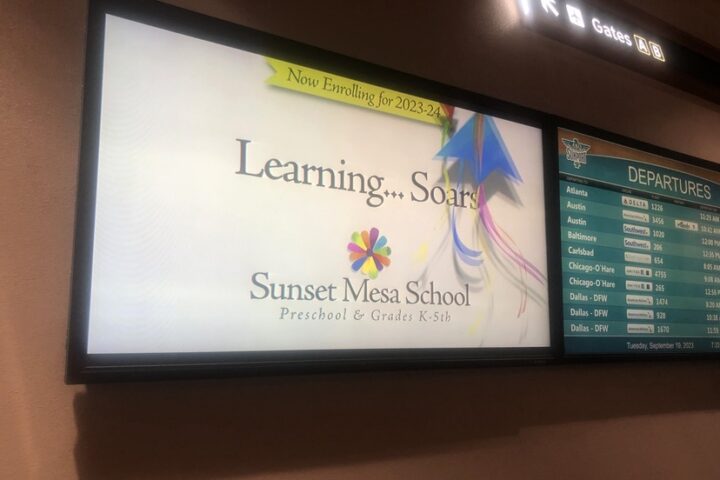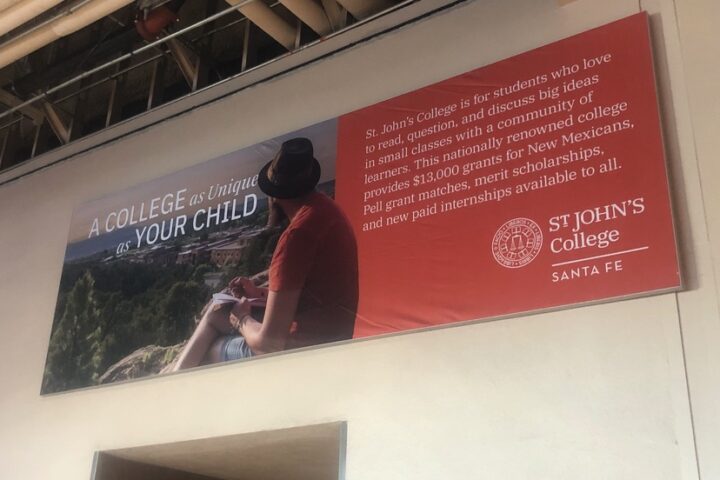The National Institutes of Health is establishing the Multi-Omics for Health and Disease Consortium… Approximately $50.3 million will be awarded to the consortium over five years, pending the availability of funds…
— from the NIH.gov website, September 12, 2023.
This past Tuesday morning, I made my way through TSA Security at the Albuquerque Airport, on my way to Juneau, Alaska to attend the Áak’w Rock music festival, billed as “the only Indigenous music festival in the U.S.”
After putting my shoes back on, I headed for Gate B1 to await my flight, and passed by a couple of large, colorful advertisements that caught my eye.


Education is an important business in America. And lately, a challenging business. You might even say, a controversial business.
We’ll be talking about education later. And controversies.
First, a few thoughts related to the importance of an ‘Indigenous music festival’.
I wrote previously about the festival, here in the Daily Post, and about my daughter Ursala’s commission to design and create theatrical backdrops for the festival’s three performance venues.
From the festival website:
It’s a three-day Indigenous music festival, held biennially on the ancestral homelands of the Tlingít (“People of the Tides”) of the Áakʼw Ḵwáan (“People of the Little Lake”). Áakʼw Ḵwáan Aaní (“Land”) is also known as Juneau, Alaska.
Music — singing and dancing — was historically an integral part of Tlingit culture…
…and it still is, even though the songs and dancing styles were nearly lost during the first 70 years of the 20th century, when incoming commercial and religious interests tried to suppress the existing Native cultural traditions in Alaska.
Maybe it’s more accurate to say, Tlingit music and dancing went ‘underground’.
In 1977, I married my girlfriend Clarissa in Juneau, and we subsequently had three children. Clarissa’s mother had Tlingit and Filipino ancestry, and her father had Filipino-Norwegian ancestry, which means, of course, that my own children have Tlingit-Filipino-Norwegian ancestry… along with English-Scottish-German ancestry from my side of the family.
At least, that’s what the biologists tell us about how ancestry works. Some sociologists might have a slightly different take on what we mean by ‘ancestry’.
Maybe ancestry is mainly cultural?
Among the Tlingit Indians (as they refer to themselves), ancestry, family traditions, and familial relationships play a more important social role than what I experienced in my own family, growing up in California. In the traditional Tlingit lifestyle, those important ‘familial’ relationships often extend even to non-humans — salmon, frog, whale, bear, deer, otter, halibut, raven, eagle, etc.
Among the Tlingit, it’s not too unusual to be living within a few miles of where your great-great-grandparents (and your non-human relatives) lived. But of course, the lifestyle has changed.
My own ancestors, meanwhile, left their homes in Europe to settle on farms on the opposite side of the globe — in Ohio, Indiana, Illinois — and then left those farms for the part of Mexico known as California. (But it was no longer part of Mexico at that point, thanks to a war of aggression sponsored by the U.S. government, from 1846-1848.)
The Indigenous tribes who had lived in ‘California’ since time immemorial had already been, or were in the process of being, forcibly displaced, when my ancestors arrived.
I continued the tradition of leaving the past behind, by moving to Alaska and raising a family there. I’m sure my mother suffered from feelings of loss, and sadness, having her only daughter move away to Seattle, and her only son running off to Alaska. But that was the family tradition. It was expected. Family ties were understood to be relatively disposable.
I suppose that leaving one’s homeland behind — as my ancestors did, repeatedly — serves to make your connection to your ancestors less and less important. You become, not a member of a family, but rather, an “individual”.
You are no longer part of your original tribal group; you become, in a sense, a lone wolf, in a foreign landscape.
An honored tradition, among my people.
And she bare him a son, and Moses called his name Gershom: for he said, ‘I have been a stranger in a strange land’…
— Exodus 2:22, King James version
Living in Alaska with Clarissa, and raising our children there, I was exposed to an Indigenous culture that treated family relationships, and ancestry, very differently from what I’d experienced growing up in California.
Which might be why a particular sentence, in a press release from the National Institutes of Health, caught my eye.
New research consortium will develop innovative strategies for clinical studies involving ancestrally diverse populations.
I have never liked the word, “race”, as applied to human ancestry.
I understand why people use that word. “Race”. We are taught, by our culture, to view the people around us as either sharing our same “racial” background, or as people of a “foreign” race. Maybe that’s our way of making ourselves feel some kind of ancestral connection — a feeling of belonging to a particular “tribe”?
After we’ve left our homelands behind?
The sad part of defining the people around us by ‘race’ is the separation it causes. The word defines us as different — in some essential sense — from people who don’t share our same ‘ancestry’.
I will go out on a limb, and make the claim that my own children cannot be defined by ‘race. How in the world can anyone claim that a person with Tlingit-Filipino-Norwegian-English-Scottish-German ancestry fits into a certain ‘racial’ category?
Go back far enough into prehistory, and none of our ancestors fit into a separate ‘racial’ category. Even the Bible suggests that.
That’s why my heart jumped, just a bit, when I read the phrase:
“…clinical studies involving ancestrally diverse populations...”
The words we choose — the way we speak about ourselves and our fellow humans — can change the world.
I won’t deny that we humans are ancestrally diverse, and that medical science has theories about why people with a particular ancestry are more prone to this or that disease or ailment.
But while the word ‘race’ serves to separate us from one another, the phrase “ancestrally diverse” seems to imply that we’re all in the same boat. Together, but diverse.
